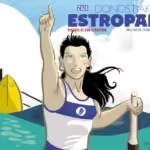The History and Significance of the Christ of Urgull in San Sebastián
Donostia-San Sebastián, with its iconic bay and the majestic Monte Urgull, is home to a symbol that has accompanied the city for decades: the sculpture of theSacred Heart of Jesusat the top of Urgull, popularly known as theChrist of UrgullThis imposing figure has become a visual beacon, a cultural and spiritual landmark for San Sebastián residents and visitors alike. Recently, the monument has been the subject of debate due to its alleged connection to the Franco regime, protected by the Democratic Memory Law, which has led to proposals for its demolition or modification.
However, a deeper look into the history of this iconic sculpture reveals a much richer and more nuanced narrative, separating it from any Francoist origins and highlighting its deep roots in popular faith and the city’s identity.
Pre-Dictatorship Origins: A Popular and Religious Initiative
The conception of the Sacred Heart of Urgull was not born from an authoritarian regime, but fromcivic fervorAt the beginning of the 20th century, the idea of consecrating the city to the Sacred Heart of Jesus, promoted by the Society of Jesus and enthusiastically embraced by the local Catholic community, took shape long before the Spanish Civil War.
@descubredonostia.com Salvemos al Sagrado Corazon ¿Sabías que el Sagrado Corazón del Monte Urgull en Donostia tiene una historia que va más allá de lo que se cuenta? 🤔 Este símbolo de San Sebastián, conocido por todos como el "Cristo de Urgull", ha generado un debate reciente, pero sus raíces son mucho más antiguas y profundas de lo que crees. 🕰️ ¿Es realmente un vestigio del pasado o el corazón que late en el alma de nuestra ciudad? ❤️ Descubre por qué este monumento es irrenunciable para la identidad donostiarra y desenmascara los mitos que lo rodean. ¡Su permanencia es un reflejo de nuestra rica herencia! ✨ ¿Qué te parece este debate? Cuéntanos tu opinión en los comentarios. 👇 Y no te quedes solo con esto, lee el artículo completo para entenderlo todo en 👇 descubredonostia.com #SagradoCorazonUrgull #Donostia #SanSebastian #MonteUrgull #HistoriaDonostiarra #PatrimonioCultural #CristoDeUrgull #LeyDeMemoriaDemocratica #DebateHistorico #IdentidadDonostiarra #DescubreDonostia
♬ sonido original – descubredonostia.com
The The foundation stone was laid in 1920, a crucial fact that places the start of the project decades before the advent of Franco’s regime. The funding for the work came fromdonations from the people of San Sebastián themselves, which underlines its popular character and the commitment of the society of the time to this monument that they felt was theirs.
Sculptor Federico Coullaut-Valera was entrusted with bringing this aspiration to life. Although the Civil War slowed down the plans, the imposing sculpture, over twelve meters tall, was finally inaugurated in 1950. While this inauguration took place under the Franco regime, it is essential to differentiate the completion date from the founding spirit.The original DNA of the Sacred Heart of Urgull is unequivocally popular and religious., not an exaltation of a dictatorship that did not even exist in 1920.
Demystifying the Franco Connection: A Contextual Analysis
Understanding the relationship between the Sacred Heart of Urgull and Francoism requires a critical and contextual approach. It is undeniable that Franco’s regime instrumentalized the Catholic religion as part of its ideology. However, this strategy does not imply that every religious manifestation completed during that period is automatically “Francoist” in essence.
The Sacred Heart of Urgull has its roots in an earlier time and in different motivations. Its visual language is purely religious,lacking the iconography typical of monuments exalting the regime(There are no imperial coats of arms, nor direct references to the dictator.) Its message is one of devotion, not a political slogan.
For the vast majority of San Sebastian residents throughout generations, the Sacred Heart Urgull has never been perceived as a Francoist symbol, but simply as “the Christ of Urgull“, a familiar figure integrated into the landscape and identity of the city.
Heritage and Spiritual Value: Beyond the Political Debate
Beyond historical considerations, Urgull’s Sacred Heart monument has an intrinsic value that transcends any political debate:
- Manifestation of Faith:For a significant portion of the community, it is a manifestation of deep-rooted faith. In a pluralistic society, questioning the legitimacy of a religious symbol of this magnitude seems paradoxical, especially when religious freedom is a cornerstone of democracy.
- Cultural and Landscape Heritage:The silhouette of the Christ of Urgull is one of theThe most iconic and beloved postcards of Donostia-San Sebastián. It is an inseparable part of theskylineSan Sebastián and the collective memory. Removing or drastically altering it would be a painful amputation of the city’s sentimental and cultural landscape, an irreparable loss to its visual identity. Monuments are material testimonies of our past; erasing them impoverishes historical understanding.
An Untimely Debate: Priorities for Donostia
The insistence on reopening the debate on the future of the Sacred Heart of Urgull seems at odds with the most pressing concerns of the citizens of San Sebastián, such as access to housing, job insecurity, sustainable tourism management, and the improvement of public services. For many, this ideological controversy diverts focus from present and future challenges.
The Counterproductive Effects of Demolition
Proposing the demolition of the Sacred Heart of Urgull under the pretext of historical memory could have counterproductive effects:
- Obstacle to Historical Pedagogy:Overcoming historical traumas is achieved through pedagogy and critical contextualization, not by eliminating vestiges. Destruction is, in a way, a form of forgetting or imposing selective forgetting, rather than learning from the past in all its complexity.
- Dangerous Precedent:Where does the revisionist zeal stop if a precedent is set for demolishing monuments based on retrospective ideological reinterpretations? This could impoverish a vast and diverse cultural heritage.
- Material and Symbolic Cost:In a context of limited public resources, the demolition or major structural modification of the Sacred Heart of Urgull would be a difficult expenditure to justify. These resources could be allocated to heritage conservation or the installation of information panels that accurately contextualize the monument’s history.
Popular Sentiment: “The Christ of Urgull” as Part of the Donostiarra Identity
It is crucial not to ignore the majority popular sentiment. There is no widespread social outcry demanding the removal of the Sacred Heart of Urgull. For many San Sebastián residents, the sculpture is simply “the Christ of Urgull“, a familiar figure, an element inherent to the landscape of his childhood and daily life, stripped in his daily perception of the political connotations that are exclusively attributed to him.
Symbols that become so deeply embedded in the urban landscape and community life for decades eventually transcend their specific origins to become part of a shared collective identity.
Conclusion: Protect Urgull’s Soul
The decision on the future of the Sacred Heart of Urgull must be considered and not based on biased interpretations or political agendas.popular and religious origin prior to Franco’s regime, are spiritual meaning, are extraordinary value as a landscape and heritage iconof Donostia-San Sebastián, and theabsence of a majority social demand for its elimination, are compelling arguments for its preservation.
Protecting the Sacred Heart Urgull is not to apologize for any past regime, but to recognize and value a significant piece of theSan Sebastian identity, of its unique landscape, and of the legacy that will be passed on to future generations. It means looking to the future with the wisdom of knowledge and respect for the past, without needing to erase the traces of a path that, with all its vicissitudes, has brought us to the present.
The soul of Urgull, with its guardian, deserves to continue contemplating the future of the beautiful Easo.



